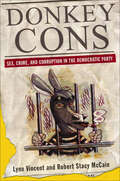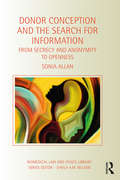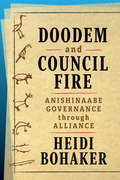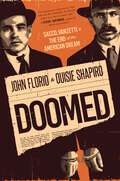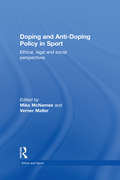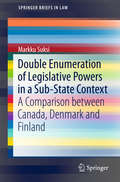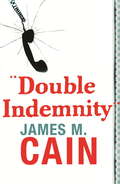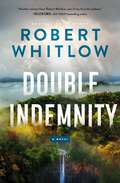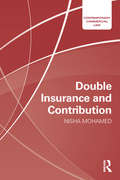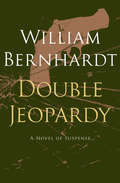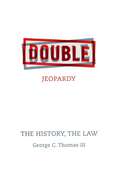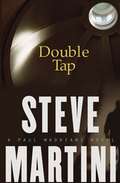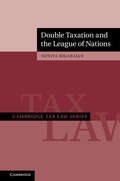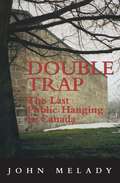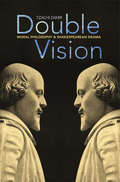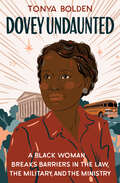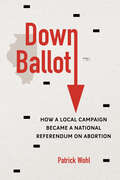- Table View
- List View
Donald Trump v. The United States: Inside the Struggle to Stop a President
by Michael S. SchmidtWith unparalleled reporting, a Pulitzer Prize–winning New York Times reporter continues to break news about the most important political story of our lives as he chronicles the clash between a president and the officials of his own government who tried to stop him. <p><p> In the early days of the Trump presidency, the people who work in the institutions that make America America saw Trump up close in the Oval Office and became convinced that they had to stand up to an unbound president. These officials faced a situation without parallel in American history: What do you do, and who do you call, if you are the only one standing between the president, his extraordinary powers, and the abyss? <p> Michael S. Schmidt’s Donald Trump v. The United States tells the dramatic, high-stakes story of those who felt compelled to confront and try to contain the most powerful man in the world as he shredded norms and sought to expand his power. <p> Schmidt has broken many of the major stories of the Trump era, from the news of Hillary Clinton’s use of a personal email account to the report on former FBI director James Comey’s contemporaneous memos of conversations with Trump that led directly to the appointment of special counsel Robert S. Mueller III. Now he takes us inside the defining events of the presidency, chronicles them up close, and records the clash between an increasingly emboldened president and those around him, who find themselves trying to thwart the president they had pledged to serve, unsure whether he is acting in the interest of the country, his ego, his family business, or Russia. Through their eyes and ears, we observe an epic struggle. <p> Drawing on secret FBI and White House documents and confidential sources inside federal law enforcement and the West Wing, Donald Trump v. The United States is vital journalism, recording the shocking reality of a presidency like no other, a riveting contemporary history, and a lasting account of just how fragile and vulnerable the institutions of American democracy really are. <p> <b>A New York Times Bestseller</b>
Donde no hago pie
by Belén López PeiróCrónica del duro proceso que sigue a la denuncia de un abuso familiar y que implica enfrentar los prejuicios de la sociedad y los obstáculos de la justicia. «Contemporáneo en su estilo breve y fragmentario -donde se cruzan diario, imágenes, géneros y lenguajes diversos-, esta novela lírica y vertiginosa revoluciona la no ficción en sus formas y temas».Gabriela Cabezón Cámara Después de un año sin noticias, una llamada desde la Fiscalía anuncia que, finalmente, la denuncia por abuso sexual ha sido elevada a juicio. Esa mañana invernal comienza para la narradora otro duro proceso: encontrar representación legal, entender las lógicas burocráticas de la Justicia, tejer redes de apoyo para afrontar la causa contra su tío, un comisario poderoso, y juntar coraje para reabrir un expediente que lleva al pasado familiar. Sin demagogias, Belén López Peiró revisa los contornos difusos de los recuerdos; ensaya respuestas al agobio de audiencias humillantes e indaga en los laberintos de los juicios por jurado. Donde no hago pie profundiza el proyecto literario de Por qué volvías cada verano, antecedente clave de miles de denuncias anónimas y otras de enorme repercusión mediática. Con un ritmo avasallante, esta crónica encuentra las palabras para transformar en acción política un delito que pretendía permanecer secreto. Sobre Por qué volvías cada verano, la crítica dijo: «Uno de los 18 mejores libros del año».Revista Rolling Stone «De una contundencia expresiva increíble».Mauro Libertella, La Agenda «Una de las autoras del año».Carolina Amoroso, TN «Uno de los textos más valientes y más crudos que apareció recientemente».Agustina Larrea, Infobae
Done Gone Wrong (Avery Andrews #2)
by Cathy PickensThe delightful Avery Andrews of Malice Domestic winner Southern Fried comes out of hiding to face a big-city trial and finds unpleasant surprises. A chance to be a part of a headline-grabbing case against a drug company has lured attorney Avery Andrews back to Charleston, South Carolina. She agrees to meet with Mark Tilman, a young doctor from her home town who seems to have something on his mind. When he doesn't show, she figures he stood her up and takes comfort in the restaurant's she-crab soup. But it turns out he had a fatal car accident. Something about the crash isn't right, and Mark's father asks Avery to look into his death. Between that and digging up dirt on the wonder drug Uplift, Avery is coming up with more questions than answers. Of course, Avery isn't the only one making headlines. Back in Dacus, her mom is on live television confronting a teenager's dynamite-toting paramour in a hostage crisis at the Burger Hut, Great-Aunt Aletha is mixing it up with the now-toupee-less postman, and the son of a ghost wants vengeance. In short, it's life as usual back in Dacus, while in Charleston, Avery is forced to face demons from her own past. "[A] richly atmospheric second novel...finely crafted." Publishers Weekly. "Pickens, a lawyer and teacher with deep roots in the Carolinas balances the dark and light aspects of the subgenre adeptly, and almost always manages to avoid corn and sentimentality." Chicago Tribune.
Donkey Cons: Sex, Crime, and Corruption in the Democratic Party
by Lynn Vincent Robert Stacy McCain“There is a double standard for Democrat and Republican criminals . . . An irresistible book that reminds us what the New York Times wants us to forget.” —David Horowitz, Publisher, FrontPage MagazineShameless bribery. Illicit sex. Sweeping corruption.“The Democratic Party is like the Gambino mob, but with matching federal funds.”In this raucous, head-spinning look at the follies and felonies of today’s most famous and infamous liberals, journalists Lynn Vincent and Robert Stacy McCain chronicle for the first time the rampant crime, sex, and corruption of the Democratic Party. Donkey Cons reveals:How corrupt Democrats in Congress outnumber corrupt Republicans by as much as three to one.How Franklin Roosevelt, Harry Truman, and John F. Kennedy were elected with the help of the Mob.What two eyewitnesses said about JFK’s obsession with hookers.How union operatives take from working families to deliver millions of dollars to Democrats.How Democrats in the 1990s covered up a conspiracy one expert called “the largest incidence of obstruction of justice in American history.”Why Democrats ignore crime victims and take the side of rapists, robbers, and cop-killers—then stump for the right of felons to vote!From bribery, kickbacks, and sex scandals to espionage, terrorism, and rape, what was once the “Party of the People” has become a party with an appallingly long rap sheet. And this hard-hitting, sad-but-funny exposé of the crimes of the Democratic Party finally puts all their misdeeds into perspective. Thoroughly researched, using outrageous anecdotes and intimate details, Donkey Cons shows that the serial corruption of the Clinton presidency wasn’t an anomaly but a developing, unnerving pattern in the modern Democratic ethos. These are the stories the Democrats don’t want you to read!
Donor Conception and the Search for Information: From Secrecy and Anonymity to Openness (Biomedical Law and Ethics Library)
by Sonia AllanThis book examines donor conception and the search for information by donor-conceived people. It details differing regulatory approaches across the globe, including those that provide for ‘open-identity’ or anonymous donation, or that take a ‘dual-track’ approach. In doing so, it identifies models regarding the recording and release of information about donors that may assist in the further development of the law, policy and associated practices. Arguments for and against donor anonymity are considered, and specifically critiqued. The study highlights contrasting reasoning and emphasis upon various interests and factors that may underpin secrecy, anonymity or openness. The book will be of value to academics, students and legal practitioners involved with this area. It is also relevant to policy makers, health practitioners and anyone with an interest in the subject.
Doodem and Council Fire: Anishinaabe Governance through Alliance (Osgoode Society for Canadian Legal History)
by Heidi BohakerCombining socio-legal and ethnohistorical studies, this book presents the history of doodem, or clan identification markings, left by Anishinaabe on treaties and other legal documents from the seventeenth through the nineteenth centuries. These doodems reflected fundamental principles behind Anishinaabe governance that were often ignored by Europeans, who referred to Indigenous polities in terms of tribe, nation, band, or village – classifications that failed to fully encompass longstanding cultural traditions of political authority within Anishinaabe society. Making creative use of natural history, treaty pictographs, and the Ojibwe language as an analytical tool, Doodem and Council Fire delivers groundbreaking insights into Anishinaabe law. The author asks not only what these doodem markings indicate, but what they may also reveal through their exclusions. The book also ooutlines the continuities, changes, and innovations in Anishinaabe governance through the concept of council fires and the alliances between them. Original and path-breaking, Doodem and Council Fire offers a fresh approach to Indigenous history, presenting a new interpretation grounded in a deep understanding of the nuances and distinctiveness of Anishinaabe culture and Indigenous traditions.
Doomed by Cartoon: How Cartoonist Thomas Nast and The New York Times Brought down Boss Tweed and His Ring of Thieves
by John Adler Draper HillThe timely, true story of Thomas Nast, the granddaddy of political satire who destroyed a corrupt regime in 19th century New York City—with cartoons. He was an unethical, bullying, and narcissistic politician; a blow-hard real estate magnate and notorious swindler; a master manipulator who thrived off voter fraud, graft, and the collusion of his right-hand sycophants. This is the 1870s. The legendary William &“Boss&” Tweed, senator and third-largest landowner in New York City, is on a roll. He and his thieving minions have already duped the city out of an estimated two-billion dollars. It wasn&’t going to be easy exposing him. He controlled the press—except for the magazine, Harper&’s Weekly. And Harper&’s had an invaluable weapon against the humorless and seemingly invincible Tweed: Thomas Nast, an influential political cartoonist who, day by day, brought Tweed&’s corruption to light. With pen and ink, and a savage and righteous wink, Thomas Nast was determined to topple an empire. Told through Nast&’s scathing 160-plus serialized cartoons, the remarkable and unbelievable true story of Nast vs. Tweed was not only unprecedented for its day, but it set the tone for the battle between the freedom of the press and political malfeasance that resonates well into the twenty-first century.
Doomed: Sacco, Vanzetti & the End of the American Dream
by Ouisie Shapiro John FlorioFrom John Florio and Emmy Award-winning writer Ouisie Shapiro comes a monumental YA nonfiction book about the heartbreaking case of Sacco and Vanzetti, two Italian immigrants who were wrongfully executed for murder.In the early 1920s, a Red Scare gripped America. Many of those targeted were Italians, Eastern Europeans, and other immigrants.When an armed robbery resulting in the death of two people broke headlines in Massachusetts, Nicola Sacco and Bartolomeo Vanzetti—both Italian immigrants—were quick to be accused.A heated trial ensued, but through it all, the two men maintained their innocence. The controversial case quickly rippled past borders as it became increasingly clear that Sacco and Vanzetti were fated for a death sentence. Protests sprang up around the world to fight for their lives.Learn the tragic history we dare not repeat in Doomed: Sacco, Vanzetti, and the End of the American Dream, an action-packed, fast-paced nonfiction book filled with issues that still resonate today.Praise for Doomed“A riveting true crime story—but who are the criminals? As relevant today as it was a century ago.” - Steve Sheinkin, author of Bomb and Fallout
Doping and Anti-Doping Policy in Sport: Ethical, Legal and Social Perspectives (Ethics and Sport)
by Verner Møller Mike McNameeThe issue of doping has been the most widely discussed problem in sports ethics and is one of the most prominent issues across sports studies, the sports sciences and their constituent disciplines. This book adds uniquely to that catalogue of discourses by focusing on extant anti-doping policy and doping practices from a range of multi-disciplinary perspectives (specifically ethical, legal, and social scientific). With contributions from a world-class team of scholars and legal practitioners from the UK, Europe and North America, the book explores key contemporary issues such as: sports medicine international doping policy the whereabouts system the criminalization of doping privacy rights, gene doping and ethics imperfection in doping test procedures steroid use in the general population. Doping and Anti-Doping Policy in Sport offers an important critique of contemporary anti-doping policy and is essential reading for any advanced student, researcher or policy maker with an interest in this vital issue.
Doping in Non-Olympic Sports: Challenging the Legitimacy of WADA? (Routledge Research in Sport, Culture and Society)
by Lovely DasguptaThis book is the first of its kind to discuss doping within Non-Olympic Sports. Sports like American football, cricket and dance sports have, in recent years, been in the news for doping activities. The scale of the incidents may differ in each of these sports, but they present interesting questions about the legitimacy of the World Anti-Doping Agency (WADA) Code. Doping in Non-Olympic Sports: Challenging the legitimacy of WADA? argues against the International Olympic Committee (IOC)-run regime where WADA Code compliance is used as the only parameter to define an activity as a sport. The book argues that the definition of modern sport is based on certain factors identified through sociological and historical research. These parameters are common across the board and do not distinguish between Olympic and Non-Olympic sports. However, the use of the word Olympic in the Non-Olympic sport terminology subjects such sports to IOC dictates. Consequently, the IOC exploits its monopoly over the word Olympics to insist on WADA Code compliances. The numerous instances of doping, as reported, go on to prove that WADA is turning a blind eye to these Non-Olympic sports. This book is the first to dissect the issue of doping within Non-Olympic sports and questions the very idea of WADA compliance as a condition precedent to defining sports going on to highlight the inbuilt inequity within the existing anti-doping system wherein a private regime is usurping the State’s discretion. The new, cutting edge research book is key reading for academics and researchers in the fields of Coaching, Sport Pharmacology, Sport Medicine, Sports Law, and the related disciplines.
Double Enumeration of Legislative Powers in a Sub-State Context: A Comparison Between Canada, Denmark And Finland (SpringerBriefs in Law)
by Markku SuksiThis book analyses a middle position between single enumerations in a regular federal-like and a regular autonomy-like distribution of legislative powers by examining constitutional legislation in three countries (Canada, Denmark and Finland) that have established separate enumerations for the national level and the sub-state level. The sub-state level consists of provinces in Canada, the Faroe Islands in Denmark and the Åland Islands in Finland. The book provides interpretations of the competence line based on double enumeration between the national parliament and the sub-state entities, where relevant, on the basis of the travaux preparatoires of the fundamental norms on which the arrangements are based, judicial or quasi-judicial resolutions of competence problems, and relevant doctrine and literature.
Double Indemnity
by James M. CainA true crime masterpiece, and highly acclaimed 1940s movie'DOUBLE INDEMNITY is among the finest of all American novels, regardless of genre or style' LA TIMES'Cain is the master' Tom WolfeDOUBLE INDEMNITY is the classic tale of an evil woman motivated by greed who corrupts a weak man motivated by lust.Walter Huff is an insurance investigator like any other until the day he meets the beautiful and dangerous Phyllis Nirdlinger and falls under her spell. Together they plot to kill her husband and split the insurance. It'll be the perfect murder . . .
Double Indemnity
by Robert WhitlowSomeone stands to gain millions of dollars from a hunter&’s accidental death . . . unless that death wasn&’t an accident.Matt and Elena Thompson present the picture of perfection. But their enviable life isn&’t all it seems. Their marriage is on the rocks, and financial disaster looms. Then Matt is killed in a hunting accident, and the questions and accusations begin to mount.Attorney Liz Acosta, newly arrived in the mountains of north Georgia after graduating from law school, plans to get some job experience on her resume before returning home to seek a position with a big-time firm. Intellectual pastor Connor Grantham isn&’t sure that shepherding a rural congregation is what he ultimately wants to do with his life. Drawn to philosophy, theology, and nature, he&’s beginning to feel more at home in north Georgia—especially after he meets the brilliant and energetic Liz.While Liz and Connor spend more time with each other and discover just how compatible two people from wildly different backgrounds can be, they&’re also being drawn into the shadowy world of Matt and Elena Thompson. As the couple&’s marriage counselor, Connor finds himself in the middle of their explosive arguments. As Elena&’s attorney, Liz is caught in the tailspin created by Matt&’s death.Together, Connor and Liz attempt to solve the mystery of what really happened to Matt. If his death is ruled an accident, then the double indemnity clause in his life insurance would go into effect, essentially doubling the payout. But as Liz sorts through the legal paperwork of who stands to gain an immense sum of money from Matt&’s death, Connor is accused of the unthinkable with much more at stake than millions of dollars.Contemporary Christian legal dramaPerfect for fans of John GrishamIncludes discussion questions for book clubs
Double Insurance and Contribution (Contemporary Commercial Law)
by Nisha MohamedDouble insurance is an issue which frequently arises in practice. Dr Nisha Mohamed delves into the problems which arise in double insurance and the attempts to provide a solution to the uncertainty of the law in this area. The book begins with a fascinating look at the history and development of the law of double insurance, outlining how it has developed, and the factors the court may take into account when deciding cases involving double insurance. Attempting to provide a common law solution where no legislation has been enacted, the book covers contemporary instances of double insurance by focusing on: the relevant clauses (rateable proportion, excess, escape and other insurance) the difficulty of the courts in providing clear principles in cases of double insurance attempts to limit or exclude liability by the insurer how the clauses work in practice court decisions in various jurisdictions the Australian position under section 45 of the Insurance Contracts Act 1984 whether the Australian position can be adopted in the United Kingdom This text combines practical experience with academic rigour and will be of significant interest to lawyers, academics and insurance industry professionals alike.
Double Jeopardy: A Novel of Suspense
by William BernhardtHanded a rotten case, a lawyer will risk his life to uncover the truthA young woman is abducted by six men, beaten, raped, and left for dead. She can only identify one of her assailants: Al Moroconi, a tough guy whose links to the attack are only circumstantial. And when Moroconi&’s first lawyer is brutally murdered, the court appoints Travis Byrne, an ex-cop turned attorney, to defend him. In a lifetime of bad breaks, this will prove the worst piece of luck Byrne has ever had. Someone is trying to frame Moroconi, but why? Byrne is determined to answer this question, but doing so will see him threatened, beaten, and framed for murder. And as he attempts to clear his name, Byrne uncovers a sickening secret for which the original crime was only a cover-up. Only the truth can save him, but in a case like this, the truth could cost him his life.
Double Jeopardy: The History, The Law
by George C. Thomas, IIIIn the first book-length book on the subject in over a quarter century, George C. Thomas III advances an integrated theory of double jeopardy law, a theory anchored in historical, doctrinal, and philosophical method. Despite popular belief, double jeopardy has never been a limitation on the legislature. It functions instead to keep prosecutors and judges from imposing more than one criminal judgment for the same offense. Determining when seemingly different offenses constitute the "same offense" is no easy task. Nor is it always easy to determine when a defendant has suffered more than one criminal judgment. Tracing American double jeopardy doctrine back to twelfth century English law, the book develops a jurisprudential account of double jeopardy that recognizes the central role of the legislature in creating criminal law blameworthiness.
Double Life: The Shattering Affair between Chief Judge Sol Wachtler and Socialite Joy Silverman
by Linda WolfeA &“spellbinding&” account of the New York judge who was brought down by prescription drugs, sexual obsession, and a shocking criminal conviction (Ann Rule). He was the top justice of New York&’s highest court. She was a stunning socialite and his wife&’s step-cousin. In 1993 Sol Wachtler was convicted of blackmail and extortion against Joy Silverman, his former mistress. How did a respected jurist and one of the most prominent men in America end up serving time in prison? Linda Wolfe starts at the beginning—from Wachtler&’s modest Brooklyn upbringing through his courtship and marriage to Joan Wolosoff, the only child of a wealthy real estate developer. Joy Fererh was three and a half when her father walked out. When she and Sol met, he was fifty-five and nearing the pinnacle of his legal career. She was a thirtysomething stay-at-home mother who, with Sol&’s help, made a career for herself as a Republican Party fundraiser. They kept their affair a secret—until an explosive mix of sex, power, betrayal, and prescription-drug abuse set the stage for the tabloid headlines of the decade.
Double Paradox
by Andrew WedemanAccording to conventional wisdom, rising corruption reduces economic growth. And yet, between 1978 and 2010, even as officials were looting state coffers, extorting bribes, raking in kickbacks, and scraping off rents at unprecedented rates, the Chinese economy grew at an average annual rate of 9 percent. In Double Paradox, Andrew Wedeman seeks to explain why the Chinese economy performed so well despite widespread corruption at almost kleptocratic levels. Wedeman finds that the Chinese economy was able to survive predatory corruption because corruption did not explode until after economic reforms had unleashed dynamic growth. To a considerable extent corruption was also a by-product of the transfer of undervalued assets from the state to the emerging private and corporate sectors and a scramble to capture the windfall profits created by their transfer. Perhaps most critically, an anti-corruption campaign, however flawed, has proved sufficient to prevent corruption from spiraling out of control. Drawing on more than three decades of data from China-as well as examples of the interplay between corruption and growth in South Korea, Taiwan, Equatorial Guinea, and other nations in Africa and the Caribbean-Wedeman cautions that rapid growth requires not only ongoing and improved anti-corruption efforts but also consolidated and strengthened property rights.
Double Tap
by Steve Martinithe latest book in Martini's Paul Madriani series. Madriani defends an ex-soldier accused of killing the head of a computer security firm. the method of execution -- a double tap -- points to a man with military experience. complicating Madriani's case is the unwillingness of the defendant to talk about his military past.
Double Taxation and the League of Nations (Cambridge Tax Law Series)
by Sunita JogarajanModern-day tax treaties have their foundations in one of the three Model Tax Treaties developed by the League of Nations in 1928. <P><P>Using previously unexplored archival material, Sunita Jogarajan provides the first in-depth examination of the development of the League's Models. This new research provides insights into questions such as the importance of double taxation versus tax evasion; the preference for source-taxation versus residence-taxation; the influence of theory and practice on the League's work; the development of bilateral rather than multilateral treaties; the influence of developing countries on the League's work; the role of Commentary in interpreting model tax treaties; and the influential factors and key individuals involved. A better understanding of the development of the original models will inform and help guide interpretation and reform of modern-day tax treaties. Additionally, this book will be of interest to scholars of international relations and the development of law at international organisations.<P> Fills a gap in the literature on double taxation.<P> The first study of the archival evidence on the establishment of the first model tax treaties dealing with double taxation.<P> Highlights relevant aspects of later tax treaty developments and the current OECD Model.
Double Trap: The Last Public Hanging in Canada
by John MeladyA dozen years before the Black Donnellys were butchered at Lucan, Ontario, another murderous rampage took place a few miles away. On June 6, 1868, three men robbed and killed a rich farmer, his wife, and her unborn child. They concocted an alibi, stuck to it, and almost got off. In fact, two of them did.The third, Nicholas Melady, went to prison and fell in love with a beautiful woman in a nearby cell. There to entrap him, she listened, learned, and led him to the gallows. When he was hanged in Goderich, hundreds watched, but thousands were late for the spectacle. They were bitterly disappointed because they had missed the last public hanging in Canada.
Double Vision: Moral Philosophy and Shakespearean Drama
by Tzachi ZamirHamlet tells Horatio that there are more things in heaven and earth than are dreamt of in his philosophy. In Double Vision, philosopher and literary critic Tzachi Zamir argues that there are more things in Hamlet than are dreamt of--or at least conceded--by most philosophers. Making an original and persuasive case for the philosophical value of literature, Zamir suggests that certain important philosophical insights can be gained only through literature. But such insights cannot be reached if literature is deployed merely as an aesthetic sugaring of a conceptual pill. Philosophical knowledge is not opposed to, but is consonant with, the literariness of literature. By focusing on the experience of reading literature as literature and not philosophy, Zamir sets a theoretical framework for a philosophically oriented literary criticism that will appeal both to philosophers and literary critics. Double Vision is concerned with the philosophical understanding induced by the aesthetic experience of literature. Literary works can function as credible philosophical arguments--not ones in which claims are conclusively demonstrated, but in which claims are made plausible. Such claims, Zamir argues, are embedded within an experiential structure that is itself a crucial dimension of knowing. Developing an account of literature's relation to knowledge, morality, and rhetoric, and advancing philosophical-literary readings of Richard III, Macbeth, Romeo and Juliet, Othello, Antony and Cleopatra, Hamlet, and King Lear, Zamir shows how his approach can open up familiar texts in surprising and rewarding ways.
Doubt in Islamic Law
by Intisar A. RabbThis book considers an important and largely neglected area of Islamic law by exploring how medieval Muslim jurists resolved criminal cases that could not be proven beyond a doubt. Intisar A. Rabb calls into question a controversial popular notion about Islamic law today, which is that Islamic law is a divine legal tradition that has little room for discretion or doubt, particularly in Islamic criminal law. Despite its contemporary popularity, that notion turns out to have been far outside the mainstream of Islamic law for most of its history. Instead of rejecting doubt, medieval Muslim scholars largely embraced it. In fact, they used doubt to enlarge their own power and to construct Islamic criminal law itself. Through a close examination of legal, historical, and theological sources, and a range of illustrative case studies, this book shows that Muslim jurists developed a highly sophisticated and regulated system for dealing with Islam's unique concept of doubt, which evolved from the seventh to the sixteenth century.
Dovey Undaunted: A Black Woman Breaks Barriers in the Law, the Military, and the Ministry
by Tonya BoldenCoretta Scott King Honor–winning author Tonya Bolden chronicles the life of an intrepid lawyer and civil rights pioneer. Dovey Johnson Roundtree was most famous for her successful defense of an indigent Black man accused of the murder of Mary Pinchot Meyer, a prominent white Washington, DC, socialite, in 1965. Despite her triumph in this high-profile case, Roundtree continued to represent the poor and the underserved. She was the first lawyer to bring a bus desegregation case before the Interstate Commerce Commission, clinching the ruling that enabled Robert F. Kennedy to enforce bus integration. She was also among the first Black women to enter the Women’s Army Auxiliary Corps, and was one of the first ordained female ministers in the African Methodist Episcopal Church. Tracing Roundtree’s life from her childhood in Jim Crow North Carolina through her adulthood, Tonya Bolden illuminates a little-known figure in American history who believed the law should serve the people, and places her firmly in the context of twentieth-century civil rights and African American culture.
Down Ballot: How a Local Campaign Became a National Referendum on Abortion
by Patrick WohlWhen an obscure primary election met the culture wars In 1990, a suburban Chicago race for the Republican Party nomination for state representative unexpectedly became a national proxy battle over abortion in the United States. But the hard-fought primary also illustrated the overlooked importance of down-ballot contests in America’s culture wars. Patrick Wohl offers the dramatic account of a rollercoaster campaign that, after attracting political celebrities and a media circus, came down to thirty-one votes, a coin toss to determine the winner, and a recount fight that set a precedent for how to count dimpled chads. As the story unfolds, Wohl provides a rare nuts-and-bolts look at an election for state office from its first days through the Illinois Supreme Court decision that decided the winner--and set the stage for a decisive 1992 rematch. A compelling political page-turner, Down Ballot takes readers behind the scenes of a legendary Illinois election.



